sensor TOYOTA YARIS HATCHBACK 2021 User Guide
[x] Cancel search | Manufacturer: TOYOTA, Model Year: 2021, Model line: YARIS HATCHBACK, Model: TOYOTA YARIS HATCHBACK 2021Pages: 568, PDF Size: 110.34 MB
Page 126 of 568
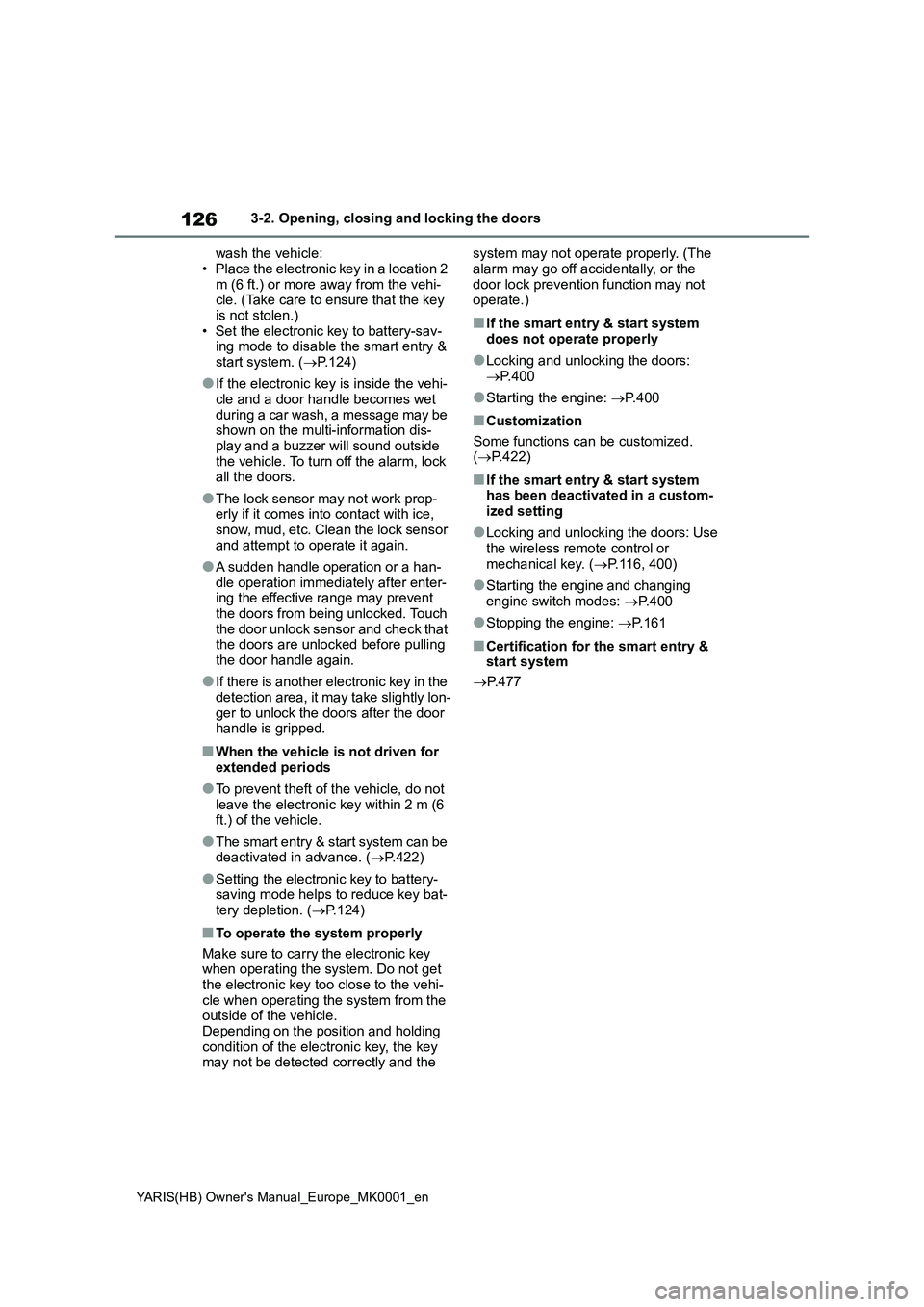
126
YARIS(HB) Owner's Manual_Europe_MK0001_en
3-2. Opening, closing and locking the doors
wash the vehicle:
• Place the electronic key in a location 2
m (6 ft.) or more away from the vehi-
cle. (Take care to ensure that the key
is not stolen.)
• Set the electronic key to battery-sav-
ing mode to disable the smart entry &
start system. (→P.124)
●If the electronic key is inside the vehi-
cle and a door handle becomes wet
during a car wash, a message may be
shown on the multi-information dis-
play and a buzzer will sound outside
the vehicle. To turn off the alarm, lock
all the doors.
●The lock sensor may not work prop-
erly if it comes into contact with ice,
snow, mud, etc. Clean the lock sensor
and attempt to operate it again.
●A sudden handle operation or a han-
dle operation immediately after enter-
ing the effective range may prevent
the doors from being unlocked. Touch
the door unlock sensor and check that
the doors are unlocked before pulling
the door handle again.
●If there is another electronic key in the
detection area, it may take slightly lon-
ger to unlock the doors after the door
handle is gripped.
■When the vehicle is not driven for
extended periods
●To prevent theft of the vehicle, do not
leave the electronic key within 2 m (6
ft.) of the vehicle.
●The smart entry & start system can be
deactivated in advance. (→P.422)
●Setting the electronic key to battery-
saving mode helps to reduce key bat-
tery depletion. (→P.124)
■To operate the system properly
Make sure to carry the electronic key
when operating the system. Do not get
the electronic key too close to the vehi-
cle when operating the system from the
outside of the vehicle.
Depending on the position and holding
condition of the electronic key, the key
may not be detected correctly and the system may not operate properly. (The
alarm may go off accidentally, or the
door lock prevention function may not
operate.)
■If the smart entry & start system
does not operate properly
●Locking and unlocking the doors:
→P. 4 0 0
●Starting the engine: →P. 4 0 0
■Customization
Some functions can be customized.
(→P.422)
■If the smart entry & start system
has been deactivated in a custom-
ized setting
●Locking and unlocking the doors: Use
the wireless remote control or
mechanical key. (→P.116, 400)
●Starting the engine and changing
engine switch modes: →P. 4 0 0
●Stopping the engine: →P. 1 6 1
■Certification for the smart entry &
start system
→P. 4 7 7
Page 136 of 568
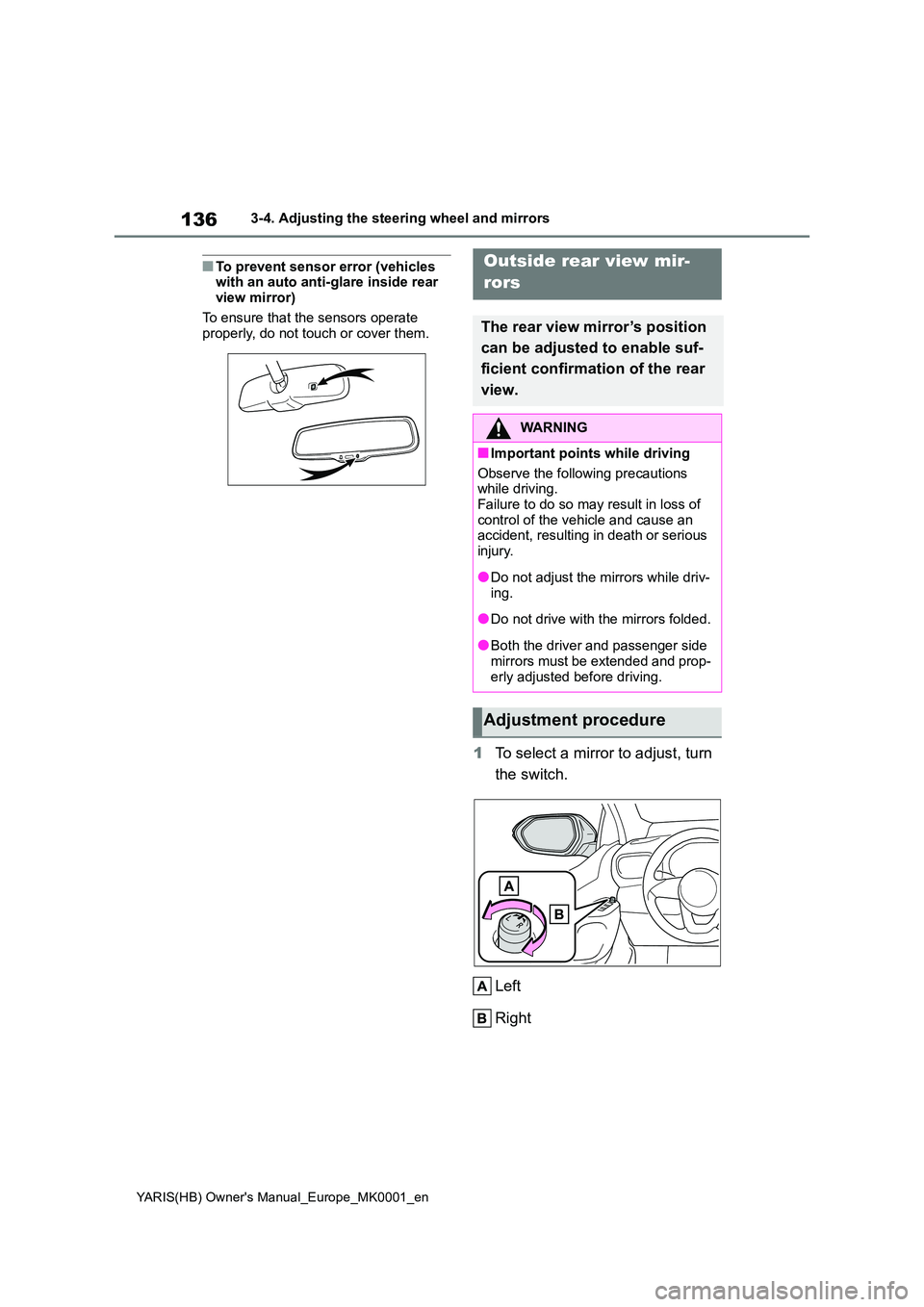
136
YARIS(HB) Owner's Manual_Europe_MK0001_en
3-4. Adjusting the steering wheel and mirrors
■To prevent sensor error (vehicles with an auto anti-glare inside rear
view mirror)
To ensure that the sensors operate properly, do not touch or cover them.
1 To select a mirror to adjust, turn
the switch.
Left
Right
Outside rear view mir-
rors
The rear view mirror’s position
can be adjusted to enable suf-
ficient confirmation of the rear
view.
WARNING
■Important points while driving
Observe the following precautions while driving.
Failure to do so may result in loss of control of the vehicle and cause an accident, resulting in death or serious
injury.
●Do not adjust the mirrors while driv-
ing.
●Do not drive with the mirrors folded.
●Both the driver and passenger side mirrors must be extended and prop-
erly adjusted before driving.
Adjustment procedure
Page 143 of 568
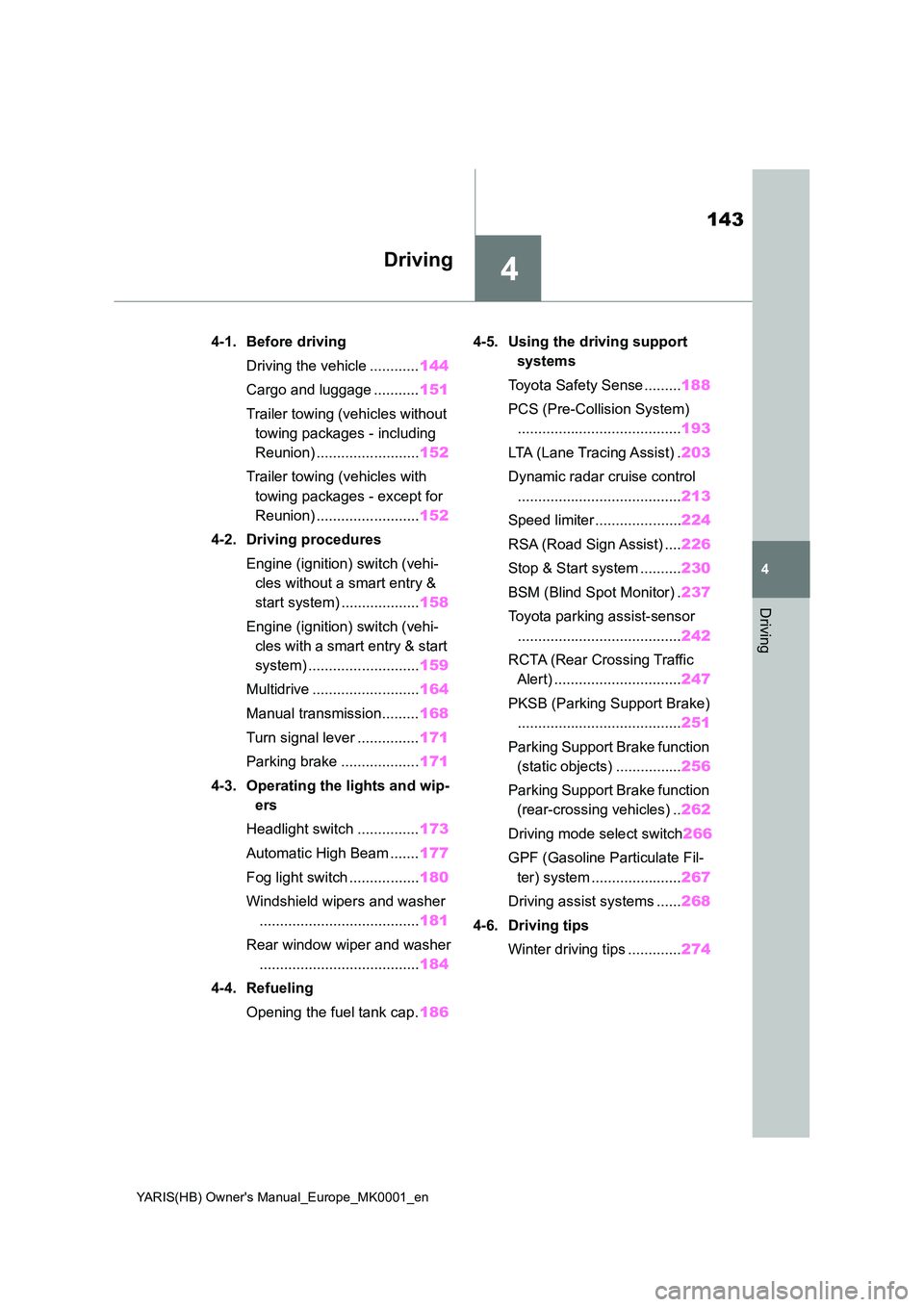
4
143
YARIS(HB) Owner's Manual_Europe_MK0001_en
4
Driving
Driving
4-1. Before driving
Driving the vehicle ............ 144
Cargo and luggage ........... 151
Trailer towing (vehicles without
towing packages - including
Reunion) ......................... 152
Trailer towing (vehicles with
towing packages - except for
Reunion) ......................... 152
4-2. Driving procedures
Engine (ignition) switch (vehi-
cles without a smart entry &
start system) ................... 158
Engine (ignition) switch (vehi-
cles with a smart entry & start
system) ........................... 159
Multidrive .......................... 164
Manual transmission......... 168
Turn signal lever ............... 171
Parking brake ................... 171
4-3. Operating the lights and wip-
ers
Headlight switch ............... 173
Automatic High Beam ....... 177
Fog light switch ................. 180
Windshield wipers and washer
....................................... 181
Rear window wiper and washer
....................................... 184
4-4. Refueling
Opening the fuel tank cap. 186
4-5. Using the driving support
systems
Toyota Safety Sense ......... 188
PCS (Pre-Collision System)
........................................ 193
LTA (Lane Tracing Assist) . 203
Dynamic radar cruise control
........................................ 213
Speed limiter ..................... 224
RSA (Road Sign Assist) .... 226
Stop & Start system .......... 230
BSM (Blind Spot Monitor) . 237
Toyota parking assist-sensor
........................................ 242
RCTA (Rear Crossing Traffic
Alert) ............................... 247
PKSB (Parking Support Brake)
........................................ 251
Parking Support Brake function
(static objects) ................ 256
Parking Support Brake function
(rear-crossing vehicles) .. 262
Driving mode select switch 266
GPF (Gasoline Particulate Fil-
ter) system ...................... 267
Driving assist systems ...... 268
4-6. Driving tips
Winter driving tips ............. 274
Page 174 of 568
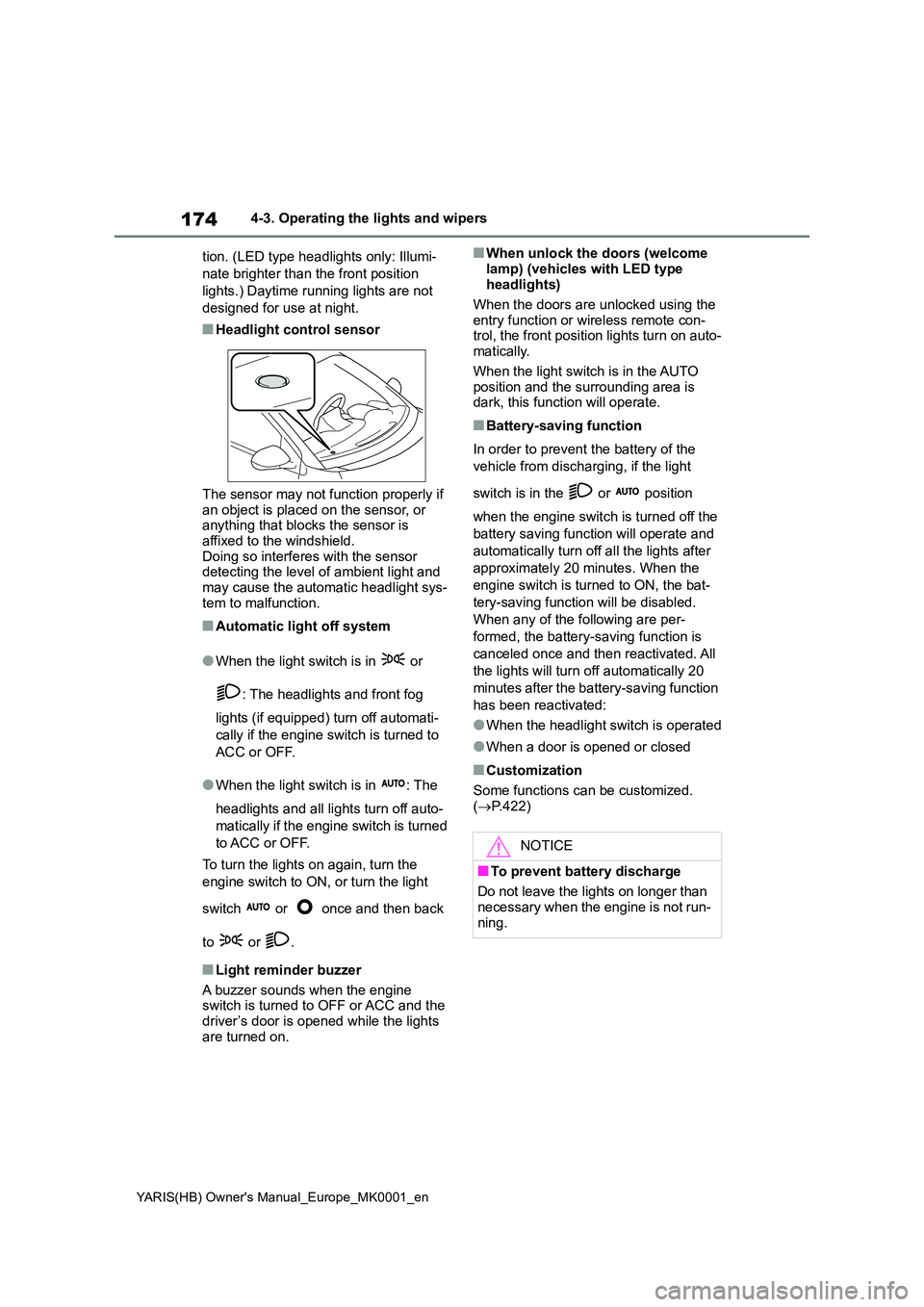
174
YARIS(HB) Owner's Manual_Europe_MK0001_en
4-3. Operating the lights and wipers
tion. (LED type headlights only: Illumi-
nate brighter than the front position
lights.) Daytime running lights are not
designed for use at night.
■Headlight control sensor
The sensor may not function properly if an object is placed on the sensor, or anything that blocks the sensor is
affixed to the windshield. Doing so interferes with the sensor detecting the level of ambient light and
may cause the automatic headlight sys- tem to malfunction.
■Automatic light off system
●When the light switch is in or
: The headlights and front fog
lights (if equipped) turn off automati-
cally if the engine switch is turned to
ACC or OFF.
●When the light switch is in : The
headlights and all lights turn off auto-
matically if the engine switch is turned
to ACC or OFF.
To turn the lights on again, turn the
engine switch to ON, or turn the light
switch or once and then back
to or .
■Light reminder buzzer
A buzzer sounds when the engine switch is turned to OFF or ACC and the
driver’s door is opened while the lights are turned on.
■When unlock the doors (welcome
lamp) (vehicles with LED type headlights)
When the doors are unlocked using the
entry function or wireless remote con- trol, the front position lights turn on auto-matically.
When the light switch is in the AUTO position and the surrounding area is dark, this function will operate.
■Battery-saving function
In order to prevent the battery of the
vehicle from discharging, if the light
switch is in the or position
when the engine switch is turned off the
battery saving function will operate and
automatically turn off all the lights after
approximately 20 minutes. When the
engine switch is turned to ON, the bat-
tery-saving function will be disabled.
When any of the following are per-
formed, the battery-saving function is
canceled once and then reactivated. All
the lights will turn off automatically 20
minutes after the battery-saving function
has been reactivated:
●When the headlight switch is operated
●When a door is opened or closed
■Customization
Some functions can be customized.
( →P.422)
NOTICE
■To prevent battery discharge
Do not leave the lights on longer than
necessary when the engine is not run- ning.
Page 177 of 568
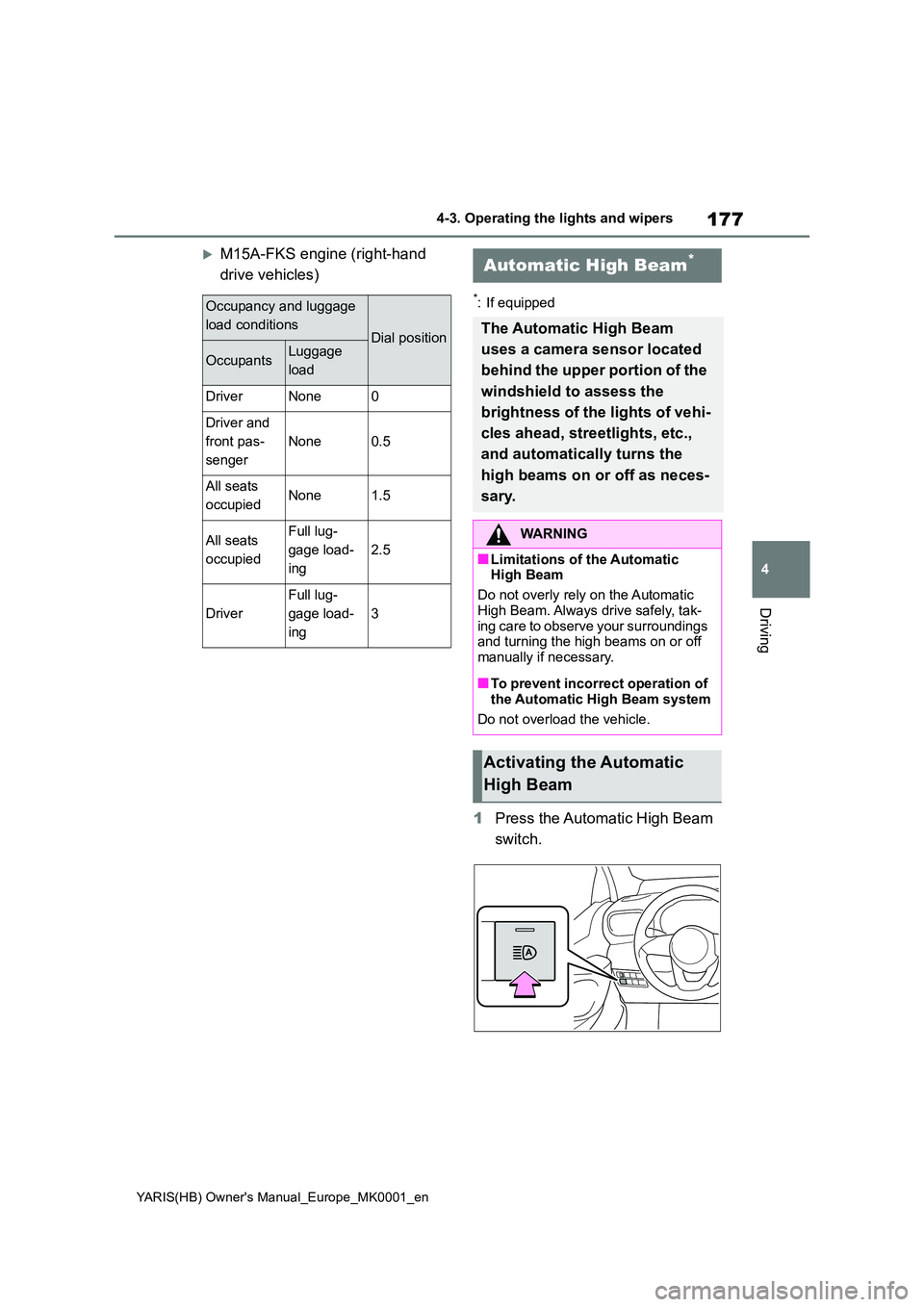
177
4
YARIS(HB) Owner's Manual_Europe_MK0001_en
4-3. Operating the lights and wipers
Driving
M15A-FKS engine (right-hand
drive vehicles)
*: If equipped
1 Press the Automatic High Beam
switch.
Occupancy and luggage
load conditionsDial position
OccupantsLuggage
load
DriverNone0
Driver and
front pas-
senger
None0.5
All seats
occupiedNone1.5
All seats
occupied
Full lug-
gage load-
ing
2.5
Driver
Full lug-
gage load-
ing
3
Automatic High Beam*
The Automatic High Beam
uses a camera sensor located
behind the upper portion of the
windshield to assess the
brightness of the lights of vehi-
cles ahead, streetlights, etc.,
and automatically turns the
high beams on or off as neces-
sary.
WARNING
■Limitations of the Automatic High Beam
Do not overly rely on the Automatic
High Beam. Always drive safely, tak- ing care to observe your surroundings and turning the high beams on or off
manually if necessary.
■To prevent incorrect operation of
the Automatic High Beam system
Do not overload the vehicle.
Activating the Automatic
High Beam
Page 178 of 568
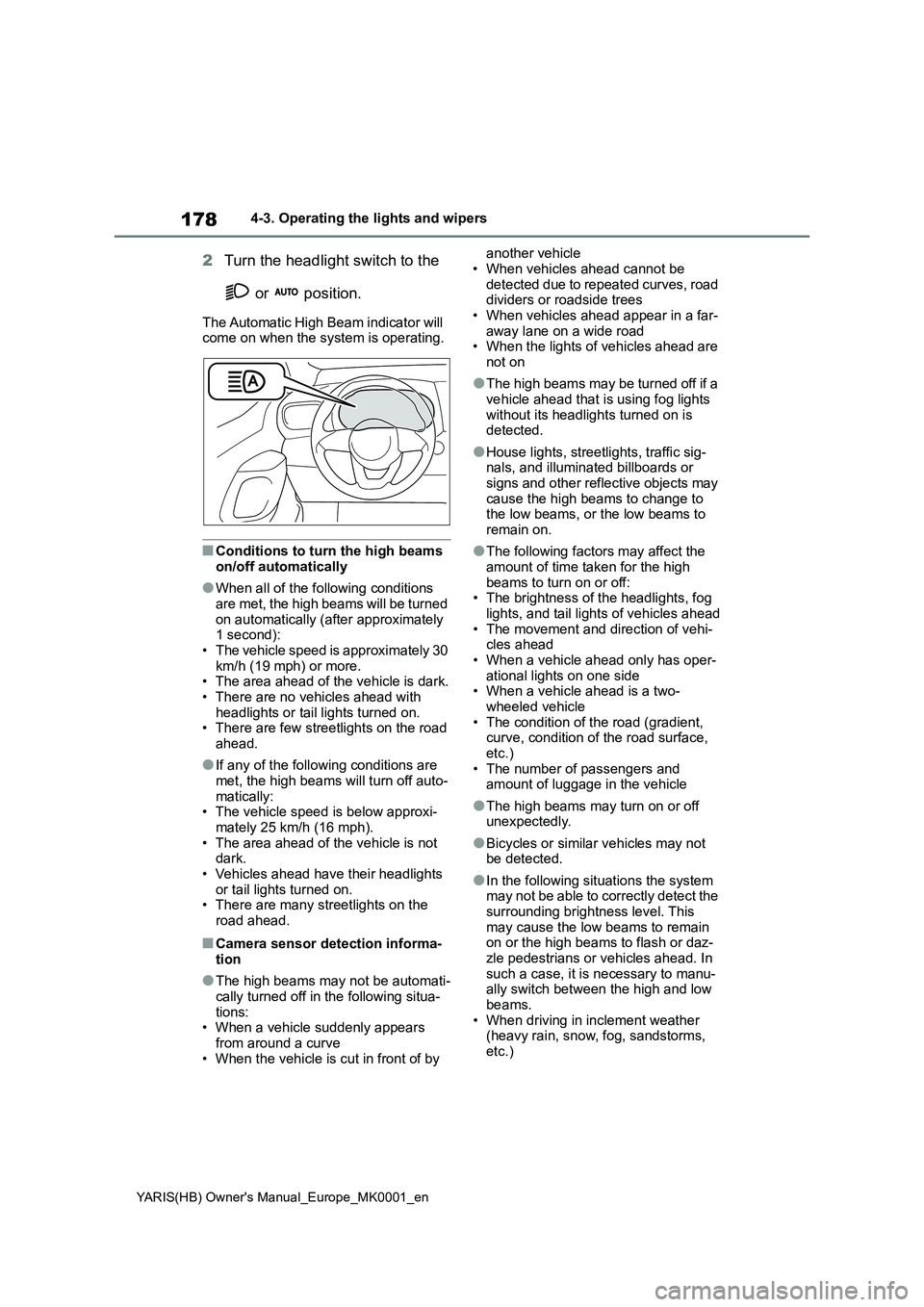
178
YARIS(HB) Owner's Manual_Europe_MK0001_en
4-3. Operating the lights and wipers
2Turn the headlight switch to the
or position.
The Automatic High Beam indicator will
come on when the system is operating.
■Conditions to turn the high beams
on/off automatically
●When all of the following conditions
are met, the high beams will be turned
on automatically (after approximately
1 second):
• The vehicle speed is approximately 30
km/h (19 mph) or more.
• The area ahead of the vehicle is dark.
• There are no vehicles ahead with
headlights or tail lights turned on.
• There are few streetlights on the road
ahead.
●If any of the following conditions are
met, the high beams will turn off auto-
matically:
• The vehicle speed is below approxi-
mately 25 km/h (16 mph).
• The area ahead of the vehicle is not
dark.
• Vehicles ahead have their headlights
or tail lights turned on.
• There are many streetlights on the
road ahead.
■Camera sensor detection informa-
tion
●The high beams may not be automati-
cally turned off in the following situa-
tions:
• When a vehicle suddenly appears
from around a curve
• When the vehicle is cut in front of by another vehicle
• When vehicles ahead cannot be
detected due to repeated curves, road
dividers or roadside trees
• When vehicles ahead appear in a far-
away lane on a wide road
• When the lights of vehicles ahead are
not on
●The high beams may be turned off if a
vehicle ahead that is using fog lights
without its headlights turned on is
detected.
●House lights, streetlights, traffic sig-
nals, and illuminated billboards or
signs and other reflective objects may
cause the high beams to change to
the low beams, or the low beams to
remain on.
●The following factors may affect the
amount of time taken for the high
beams to turn on or off:
• The brightness of the headlights, fog
lights, and tail lights of vehicles ahead
• The movement and direction of vehi-
cles ahead
• When a vehicle ahead only has oper-
ational lights on one side
• When a vehicle ahead is a two-
wheeled vehicle
• The condition of the road (gradient,
curve, condition of the road surface,
etc.)
• The number of passengers and
amount of luggage in the vehicle
●The high beams may turn on or off
unexpectedly.
●Bicycles or similar vehicles may not
be detected.
●In the following situations the system
may not be able to correctly detect the
surrounding brightness level. This
may cause the low beams to remain
on or the high beams to flash or daz-
zle pedestrians or vehicles ahead. In
such a case, it is necessary to manu-
ally switch between the high and low
beams.
• When driving in inclement weather
(heavy rain, snow, fog, sandstorms,
etc.)
Page 179 of 568
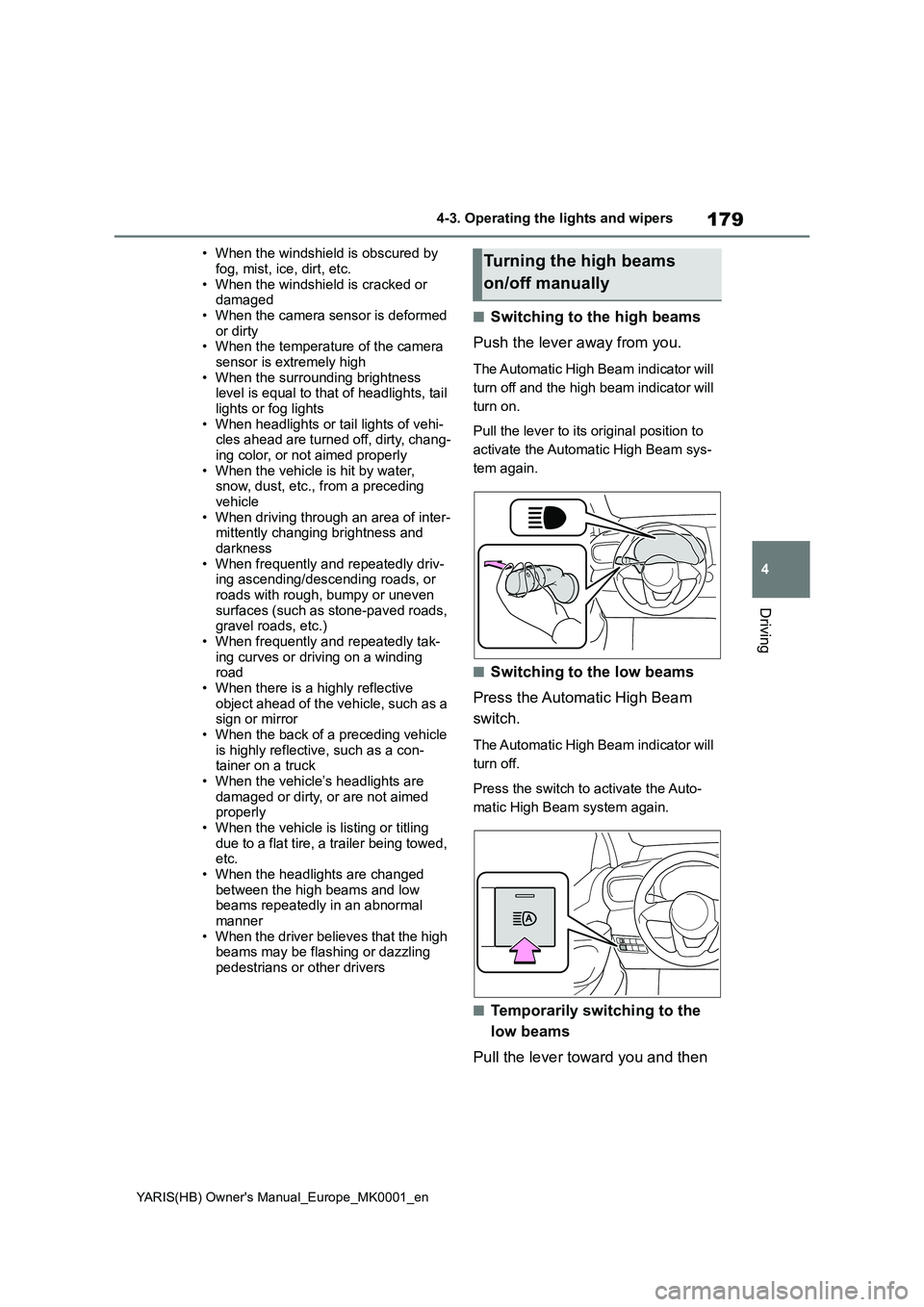
179
4
YARIS(HB) Owner's Manual_Europe_MK0001_en
4-3. Operating the lights and wipers
Driving
• When the windshield is obscured by
fog, mist, ice, dirt, etc. • When the windshield is cracked or damaged
• When the camera sensor is deformed or dirty• When the temperature of the camera
sensor is extremely high • When the surrounding brightness level is equal to that of headlights, tail
lights or fog lights • When headlights or tail lights of vehi-cles ahead are turned off, dirty, chang-
ing color, or not aimed properly • When the vehicle is hit by water, snow, dust, etc., from a preceding
vehicle • When driving through an area of inter-mittently changing brightness and
darkness • When frequently and repeatedly driv-ing ascending/descending roads, or
roads with rough, bumpy or uneven surfaces (such as stone-paved roads, gravel roads, etc.)
• When frequently and repeatedly tak- ing curves or driving on a winding road
• When there is a highly reflective object ahead of the vehicle, such as a sign or mirror
• When the back of a preceding vehicle is highly reflective, such as a con-tainer on a truck
• When the vehicle’s headlights are damaged or dirty, or are not aimed properly
• When the vehicle is listing or titling due to a flat tire, a trailer being towed, etc.
• When the headlights are changed between the high beams and low beams repeatedly in an abnormal
manner • When the driver believes that the high beams may be flashing or dazzling
pedestrians or other drivers
■Switching to the high beams
Push the lever away from you.
The Automatic High Beam indicator will
turn off and the high beam indicator will
turn on.
Pull the lever to its original position to
activate the Automatic High Beam sys-
tem again.
■Switching to the low beams
Press the Automatic High Beam
switch.
The Automatic High Beam indicator will
turn off.
Press the switch to activate the Auto-
matic High Beam system again.
■Temporarily switching to the
low beams
Pull the lever toward you and then
Turning the high beams
on/off manually
Page 182 of 568
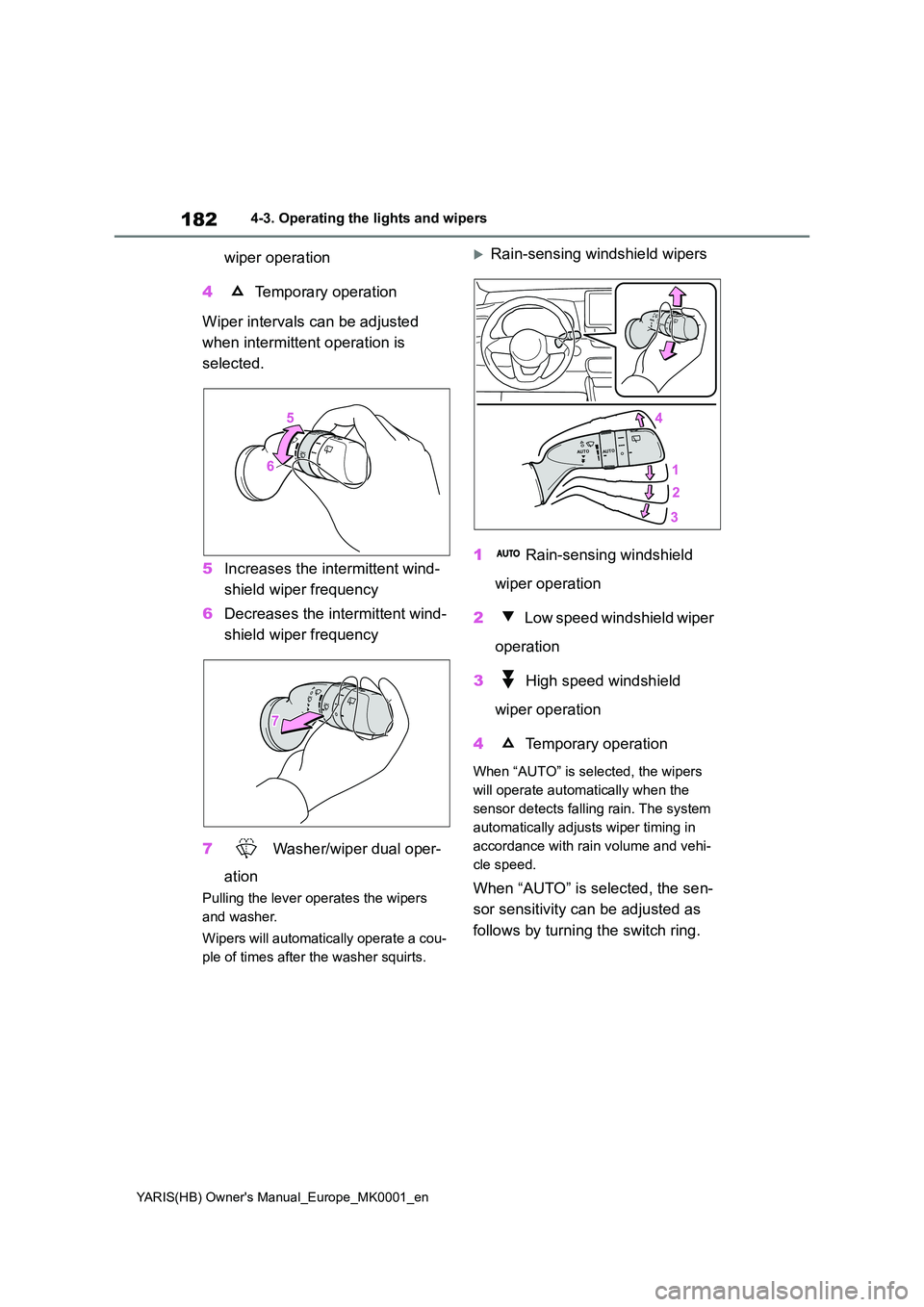
182
YARIS(HB) Owner's Manual_Europe_MK0001_en
4-3. Operating the lights and wipers
wiper operation
4 Temporary operation
Wiper intervals can be adjusted
when intermittent operation is
selected.
5 Increases the intermittent wind-
shield wiper frequency
6 Decreases the intermittent wind-
shield wiper frequency
7 Washer/wiper dual oper-
ation
Pulling the lever operates the wipers
and washer.
Wipers will automatically operate a cou-
ple of times after the washer squirts.
Rain-sensing windshield wipers
1 Rain-sensing windshield
wiper operation
2 Low speed windshield wiper
operation
3 High speed windshield
wiper operation
4 Temporary operation
When “AUTO” is selected, the wipers
will operate automatically when the
sensor detects falling rain. The system
automatically adjusts wiper timing in
accordance with rain volume and vehi-
cle speed.
When “AUTO” is selected, the sen-
sor sensitivity can be adjusted as
follows by turning the switch ring.
Page 183 of 568
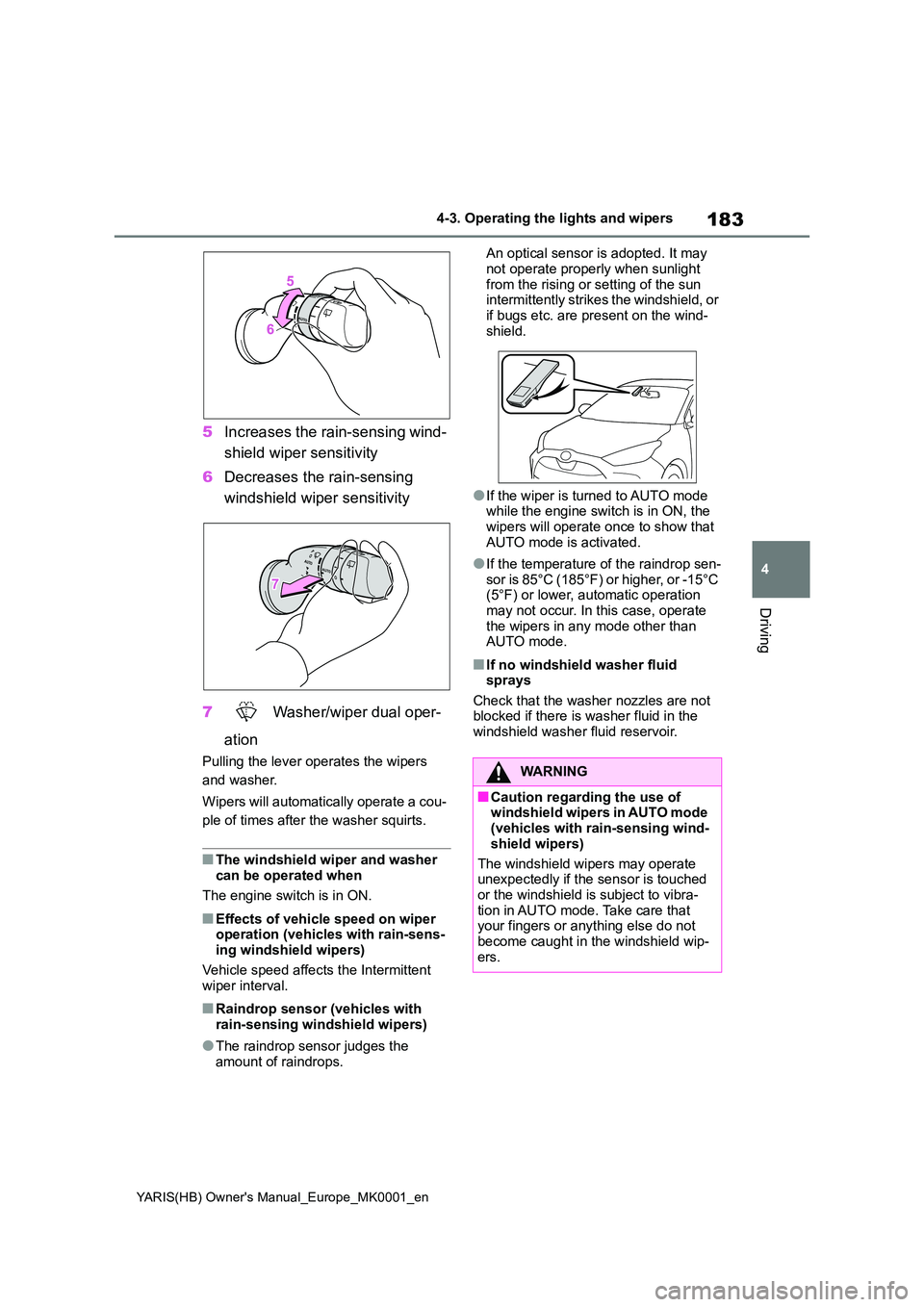
183
4
YARIS(HB) Owner's Manual_Europe_MK0001_en
4-3. Operating the lights and wipers
Driving
5Increases the rain-sensing wind-
shield wiper sensitivity
6 Decreases the rain-sensing
windshield wiper sensitivity
7 Washer/wiper dual oper-
ation
Pulling the lever operates the wipers
and washer.
Wipers will automatically operate a cou-
ple of times after the washer squirts.
■The windshield wiper and washer can be operated when
The engine switch is in ON.
■Effects of vehicle speed on wiper operation (vehicles with rain-sens-ing windshield wipers)
Vehicle speed affects the Intermittent wiper interval.
■Raindrop sensor (vehicles with rain-sensing windshield wipers)
●The raindrop sensor judges the amount of raindrops.
An optical sensor is adopted. It may
not operate properly when sunlight from the rising or setting of the sun intermittently strikes the windshield, or
if bugs etc. are present on the wind- shield.
●If the wiper is turned to AUTO mode while the engine switch is in ON, the wipers will operate once to show that
AUTO mode is activated.
●If the temperature of the raindrop sen-
sor is 85°C (185°F) or higher, or -15°C (5°F) or lower, automatic operation may not occur. In this case, operate
the wipers in any mode other than AUTO mode.
■If no windshield washer fluid sprays
Check that the washer nozzles are not blocked if there is washer fluid in the windshield washer fluid reservoir.
WARNING
■Caution regarding the use of windshield wipers in AUTO mode (vehicles with rain-sensing wind-
shield wipers)
The windshield wipers may operate unexpectedly if the sensor is touched
or the windshield is subject to vibra- tion in AUTO mode. Take care that your fingers or anything else do not
become caught in the windshield wip- ers.
Page 188 of 568
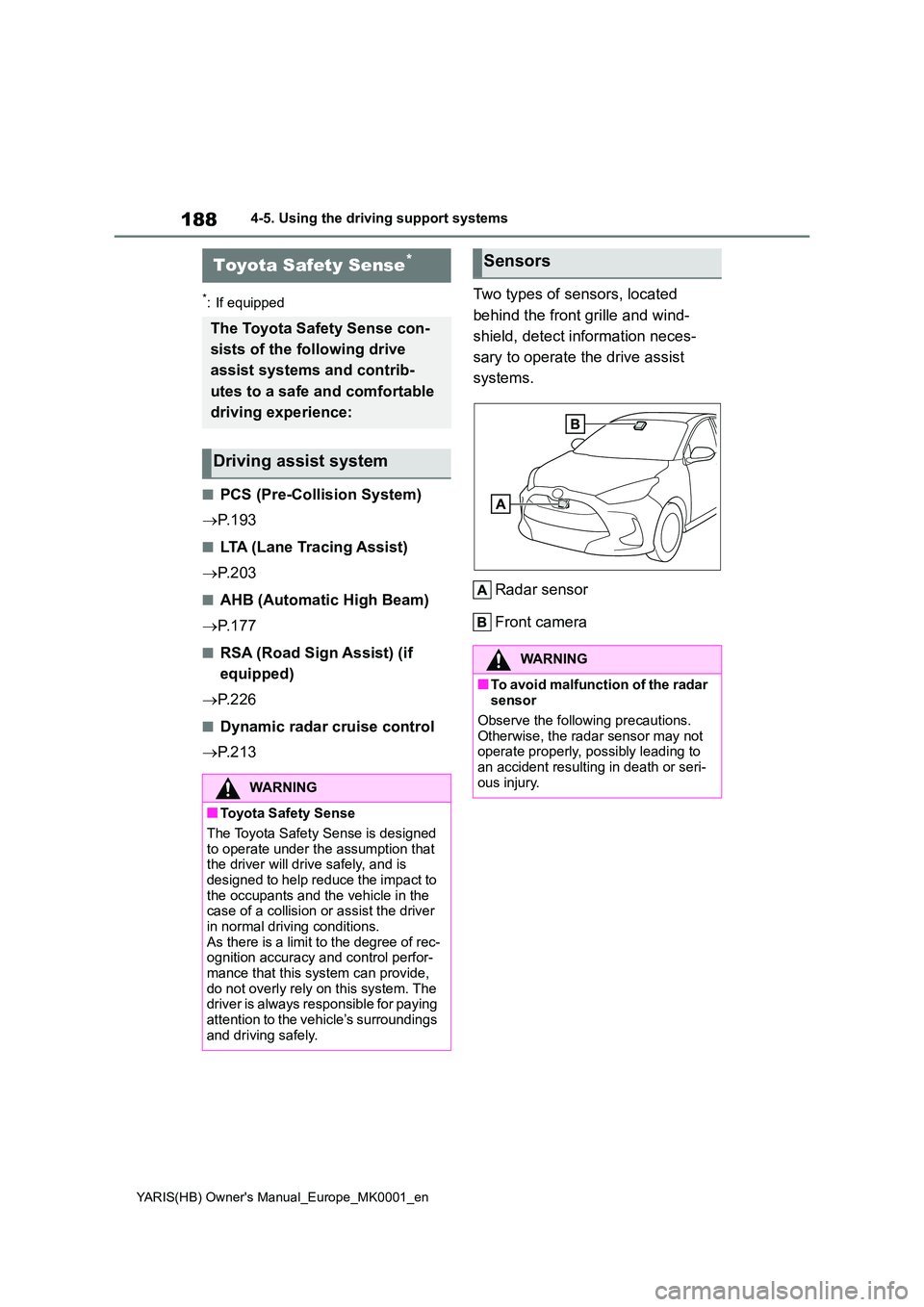
188
YARIS(HB) Owner's Manual_Europe_MK0001_en
4-5. Using the driving support systems
4-5.Using the d riving s upport sy ste ms
*: If equipped
■PCS (Pre-Collision System)
→ P. 1 9 3
■LTA (Lane Tracing Assist)
→ P. 2 0 3
■AHB (Automatic High Beam)
→ P. 1 7 7
■RSA (Road Sign Assist) (if
equipped)
→ P. 2 2 6
■Dynamic radar cruise control
→ P. 2 1 3
Two types of sensors, located
behind the front grille and wind-
shield, detect information neces-
sary to operate the drive assist
systems.
Radar sensor
Front camera
Toyota Safety Sense*
The Toyota Safety Sense con-
sists of the following drive
assist systems and contrib-
utes to a safe and comfortable
driving experience:
Driving assist system
WARNING
■Toyota Safety Sense
The Toyota Safety Sense is designed to operate under the assumption that the driver will drive safely, and is
designed to help reduce the impact to the occupants and the vehicle in the case of a collision or assist the driver
in normal driving conditions. As there is a limit to the degree of rec-ognition accuracy and control perfor-
mance that this system can provide, do not overly rely on this system. The driver is always responsible for paying
attention to the vehicle’s surroundings and driving safely.
Sensors
WARNING
■To avoid malfunction of the radar sensor
Observe the following precautions.
Otherwise, the radar sensor may not operate properly, possibly leading to an accident resulting in death or seri-
ous injury.